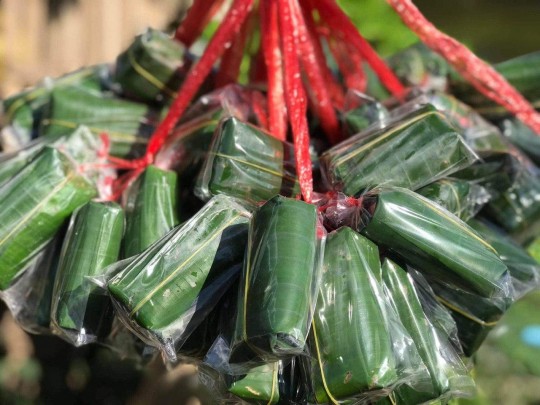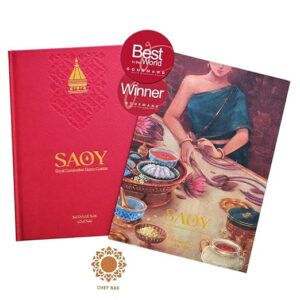Nem (ណែម) is one of the well-known Khmer delicacies of raw spiced fish wrapped up in Banana leaves, mixed with many other ingredients. This Khmer snack is very popular among young people because it could have a robust spicy and sour flavor and makes you eat a lot of sweets to calm down the exotic aftertaste.
Popular Area That Nem Khmer Snack Becomes Famous

As you approach Battambang province along National Road No.5, parcels of Nem are noticeably seen hanging on the stalls. You can find them displayed in various public places and markets in the province as well.
Mrs. Nguon Phally, a 43-year-old from Chrey Kwong Village, and her family have been selling Nem since 1987 to support their daily living. “Nem is a Khmer family favorite, it is also served during weddings and other celebrations”, Mrs. Phally said.
How is Nem Made At Home?
Battambang province is the first place that springs to mind for residents when they think about Nem, because of its reputation for making delightful Nems. Making a Nem Khmer snack is something that Battambang people have done for decades. There are numerous different kinds of Nems, including Fish Nems (Battambang Nems), Pork Nems, and Shrimp Nems. Battambang has a unique form of cooking that does not involve the use of fire.
Garlic, Coriander, honey, and salt are combined with raw fish in this dish. In a food processor, blend those ingredients together until the meat transforms to a minced-dry level, at which point you may stop the blender. Then, put the mixture in banana leaves or bags then, pack it down tightly. Insert the bird-eye chilies and bay leaves as much as you want and wrap them up tightly to exclude the air out from Nem.
During the storage period of two days and two nights avoiding exposure to sunlight and without refrigeration, Nem will be cooked and turned to be sour, and you can enjoy this tasty delicacy.
Furthermore, another type of grilled sour Nem wrapped in banana leaves was called “Sangvak”. Some people eat Nem together with Cambodian rice noodles, and other favorite vegetables such as salad, herbs, cucumber, and fish sauce.
Nem On The Market
Furthermore, Nem made with Chadow fish (Great snakehead fish) sold in the local market is popular in the province. Chadow (Great snakehead fish) is skinned and deboned before it is pounded with other ingredients turning into a paste. The fish meat is then formed into small balls or rectangular shapes and wrapped in banana leaves or plastic wrappers.
A 20 kg of fish can make only about 7kg of Nem– that is about 3000 individually wrapped Nems. The price for 100 pcs. of small parcels of Nem cost 15,000 riels (approximately US$3.53) while 100 pcs. of the bigger ones cost 4,0000 riels (US$10).
In Battambang, the production and sales of Nem are a means of livelihood for most families, and each has its own unique recipe. However, there is no statistic available yet regarding the exact number of people depending on this kind of livelihood. But remember, every purchase you make of Nem from Battambang surely gives income to these families.
Standardized Technology Behind Nem Making Procedures
Nem is a fermented semi-dry sausage that has not been well-cooked. They are often wrapped in banana leaves and left to soak for 3 to 5 days (depending on the season) at 30°C and 50% humidity. In addition, rice is used as a valuable ingredient and as a carbohydrate source for the production of lactic acid during fermentation.
For Cambodia, fermentation arises at high ambient temperatures, which is one of the dangers of bacterial proliferation, which we do not need if lactic acid is not produced in the early stages of production. Therefore, dextrose, which is identical to glucose, was added to make fermentation start quickly as the metabolism process in single rice is very slow.
The Measurement That Should Be Followed:
- Rice is typically consumed in the range of 2.5% to 4.0%;
- Nem can contain up to 5% of garlic;
- Pepper can be used in 0.1%.
If you follow the natural way (without using bacteria such as starter culture) to start breaking the yeast:
- Increase the salt amount to 3%;
- Raise the temperature to 30°C. Ferment it for 3 days at 30°C or 5 days if the temperature is below 24°C.
- Store in a cool place.
How To Make Nem From Raw Fish
Rice is used as a supplement and a source of carbohydrates since it is used to help with seizures. The mixing of fish with pork achieves the highest score in its tasty flavor.
Production Flow of Raw Spiced Fish
First, you should start with washing, cleaning, and gutting the fish. Then, separate the flesh from bones and skin. For red meat, you need to cure it with salt and nitrite. You can soak it in the water for white meat, then press it. After that, you can add all the ingredients with pork fat and grind them together. Next, you need to make stuffing into the casing. Now it is a thermal process, then cool it down before you can pack and store it properly.
Benefits of Making Raw Fish Nem
- Raw materials are cheap;
- Easy to do with production;
- All fish species can be consumed with only the meat, and they remove bones and skin;
- As a product providing health benefits.
Disadvantages of Making Raw Fish Nem
- To improve the texture, fish needs to be mixed with lard or other vegetable oils, meats, and additives such as soybean protein powder starch or carrageenan.
- The final flavor still tastes like fish, even though many other types of meat are mixed.
Noticeable Considerations When Choosing The Meat
Fresh fish must be properly frozen and consumed within 2 to 3 days after fishing. You may not know that Nem made from fish with white flesh has better visibility and less fishy taste. Furthermore, frozen fish is suitable for the making process as it is ensured with good quality before being frozen; however, fresh fish still has better elasticity.
On top of that, fish with white meat should be stored well at cold temperatures rather than fatty fish because the fat will freeze at some point. Fatty fish should not be frozen for more than 6 months at -30°C, while white meat fish can be frozen at -30°C for up to 9 months. To defrost the fish, you can store it in an ice bucket or using a tap water stream.
Gallery






